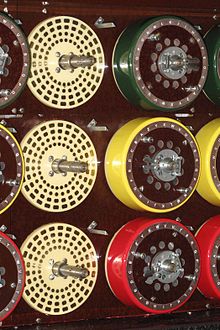Letchworth-Enigma

Letchworth-Enigma (in the English original: Letchworth Enigma ) was a model conception of the set of rollers of the Enigma key machine used by the German Wehrmacht to encrypt its communications during World War II , initially devised as a thought experiment by the British cryptanalyst Alan Turing (1912–1954) . His idea was then put into practice and served within the eponymous Turing bomb the Code Breakers of Bletchley Park ( BP ) to successfully break the German machine and deciphering the encrypted German radio messages .
Name origin
The name was derived from the English city of Letchworth (actually Letchworth Garden City ), which is about 50 km north of London and 35 km east of Bletchley , and in which the British Tabulating Machine Company (BTM) was based. This British company , originally founded to manufacture tabulating machines , built the electromechanical machines BP needed .
principle
In the German original , electric current runs through the set of rollers (sketch on the left) twice, namely first from right to left and then from left to right. It is directed back by the reversing roller (6) . As a result, the current flows both in and out via the entry roller (4) .
This proves to be disadvantageous for both the theoretical cryptanalysis and the practical realization of the fraction, especially when it comes to connecting several Enigmas one behind the other. For this it is necessary to separate electrical inputs and outputs from one another. Turing succeeded in doing this by - initially mentally - transforming the reverse roller (VHF) into a through roller. To do this, he doubled their contacts from 26 to twice 26, now - unlike the original - separately as 26 input contacts and 26 output contacts . As a result, he achieved that the VHF no longer “ reflects ” the current , but now “ transmits ” it, i.e. lets it through. This enabled him, in addition to the three rotating rollers (5) that were initially available, to arrange a second set of rollers, also made up of three rotating rollers, “behind” (i.e. to the left of in the sketch) the VHF.
In this way he succeeded in separating the input and output contacts of the roller set, which were identical in the original, which is a considerable advantage for the cryptanalysis. After separating the input and output signals, any number of Letchworth Enigmas can be cascaded by feeding the output signal of one machine into the input of the next. The concept of the Letchworth Enigma was also referred to in BP as the Opened Out Enigma ( German "open Enigma" ).
Also in the practical realization of the in quantities of more than 300 in the United Kingdom and the United States built bomb his idea was implemented in such a way with a clever detail was to the round trip of the current (doubled by now to from three to six and) to realize separate rollers each on a single drum with the help of four concentric contact circles. Therefore, the Letchworth Enigma does not need six, but only three drums. The picture shows a relevant section of a realistic replica in Bletchley Park (right picture) .
literature
- Jack Copeland : The Essential Turing. Clarendon Press 2004. ISBN 0-191-52028-4 .
- Tony Sale : Alan Turing at Bletchley Park in World War II. PDF; 0.9 MB (English), accessed on April 20, 2018.
Web links
- Virtual Wartime Bletchley Park by Tony Sale. Explanations and principle drawing of the Letchworth Enigma , accessed on April 20, 2018.
Individual evidence
- ↑ The US 6812 Bomb Report 1944 . 6812th Signal Security Detachment, APO 413, US Army. Publication, Tony Sale, Bletchley Park 2002. p. 9, accessed April 20, 2018. PDF; 1.3 MB
- ^ Gordon Welchman: The Hut Six Story - Breaking the Enigma Codes . Allen Lane, London 1982; Cleobury Mortimer M&M, Baldwin Shropshire 2000, p. 11. ISBN 0-947712-34-8
- ↑ Jack Copeland: The Essential Turing. Clarendon Press 2004, p. 318, ISBN 0191520284 .
- ↑ Tony Sale: Alan Turing at Bletchley Park in World War II. P. 444.


